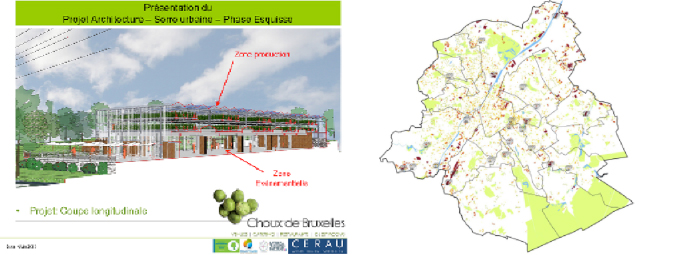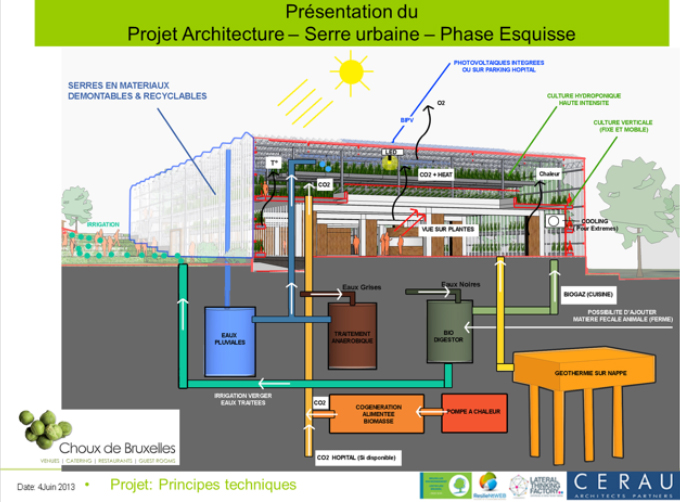Indoor farming
2. September, 2013
Contributor: Brussels
A combined building project that can accommodate both catered event activities and indoor horticultural production activities.
Motivations
The Brussels Region (162,447,439m²) is surrounded by two other regions without any possibility of regional peri-urban production (within its borders) and little land still available for urban agriculture. Therefore inventories of the surfaces of flat roofs were made:
Offices, warehouses, factories, garages, schools, hospitals, etc. = 4377 flat roofs = 5,906,888m²
61 roofs > 10,000m² = 1,288,124m²; 342 roofs > 3000m² = 1,569,870m²; 1145 roofs > 1000m² = 1,802,794m²
Results
Indoor Farming Project
A feasibility study to validate Indoor Farming as a business option to be promoted by Brussels Environment in the region and documents/tools to help the administration to assist promoters interested in Indoor Farming.
A combined building project that can accommodate both catered event activities and indoor horticultural production activities. A model specifications book will be produced for the region to serve as a source of inspiration for contracting clients and project managers.
The idea is also to motivate a maximum number of businesses (including project managers and companies active in construction) to work together on a project of this type (pilot building) in order to illustrate a range of innovative solutions in the region.
For indoor production, this then involves producing throughout the year in a short-chain production distribution approach, with production intended for consumption onsite (at catered events) or in the region.
The “close the loop” approach is sought for all the technical aspects related to flows of materials and energy. In the study, the building should approach operational autonomy in terms of materials and energy flows.
The deliverables are:
- A toolbox adapted to the region (guide to start a greenhouse activity)
- The Map of opportunities for the region (space availability, consumer density, raw materials accessibility, zoning…)
- The potential spatial configurations + Business model related (categories of buildings, scenarios of mixed areas and options, private and public buildings…) (purpose: guide to select BM related to spatial configuration, raw materials access and consumers density
- An architectural and engineering matrix (from low cost greenhouse for social purpose to high tech greenhouse for intensive agriculture production) (purpose: guide to select best architecture and engineer option regarding localization, spatial configuration and BM)
Resilient web project (-> 2015)
Brussels Environment is currently directing an Interreg IVB (resilient web) project aiming to establish a strategy of sustainability in business, reflected in implementation of eco-innovation.
The project focuses on the construction, food and tourism sectors.
Each project partner shall: Select local companies willing to participate to the RESILIENTWEB program and coach them to develop innovative products or services in the greenhouse business.
For the Brussels Region, the two Brussels partners (Brussels Environment and BECI) have decided to work on the indoor farming project to implement three pilot worksites, including that of the “Choux de Bruxelles” project (see illustration)
Benefits
“Recycling” of the flows between the greenhouse and the building: heat exchange, use of greywater, CO2…
Pro and Contra
Pro
- High-technology greenhouses produce 40 -> 90 kg/m2/yr (versus 30 for a traditional greenhouse)
- Notable interest from building contractors, the only possible source of technical innovation.
Contra
- Cost of high-technology greenhouses! (profitability to be proven)
- No organic certification possible in hydroponics
What are the lessons learn to be used/transferred/implemented in the other partner cities?
- Cross-disciplinary nature: (sustainable) construction/urban agriculture
- Innovative, exploratory technical expertise
- Toolbox & business models
Question to the network
- Existence of examples with technical innovations? Profitable business models?
- What is the role of this innovative agriculture compared to more traditional urban agriculture?

